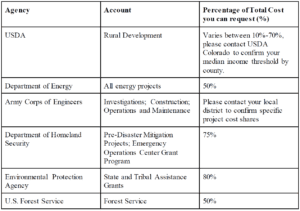What is Congressionally Directed Spending (CDS) and what can it be used for?
As part of the appropriations process, members can request CDS (previously known as earmarks) for specific projects in their home state for the Senate Appropriations Committee to consider. Funding for CDS projects is contingent upon a project being included in legislation, and passed by both the House of Representatives and Senate. Funding, if awarded, will likely be distributed in the fiscal year 2024 (October 2023 – September 2024).
APPLICATION PROCESS
1. How can my organization apply for CDS?
Our office will accept CDS requests from February 21 – March 10, 2023. Requests must be submitted through the form on our website that can be found HERE. Our office will not consider requests received outside the form.
2. What information do I need to complete the request form?
● Organization contact information
● A point of contact for all project specifics within your organization
● Detailed description of the purpose and scope of your project
● Itemized budget
● Your organization’s Employer Identification Number (EIN)
● Details on any other CDS request your organization has made or will make this year
● Any other federal funding your project has secured including federal grants, loans, or CDS from previous years.
3. Do I need to provide any supporting documentation?
One letter of support from either the state government, local governments, tribal governments, or other community leaders that identify the community benefits and support for the project. This letter must be emailed as a PDF to directedspending@bennet.senate.gov
4. What agencies and accounts are accepting CDS requests?
A list of the subcommittees that are accepting accounts that are accepting CDS requests is available at the end of this document. This list contains very few changes from the fiscal year 2023 process.
FREQUENTLY ASKED QUESTIONS
1. Can I submit projects to more than one member of Congress?
Yes, you can submit the project to every member of the congressional delegation who represents the location where the project will be implemented AND is accepting requests. If you submit the same project to multiple members of Congress, we ask that your application be identical and that you note the other members to whom you have submitted your project in your application.
2. Which agency and/or account should I select for my project?
Please review the list of Senate Appropriations subcommittees and examples of previously approved CDS projects, which can be found HERE. Feel free to follow up with one of our Regional Offices if you have further questions. Eligible agencies and accounts can be viewed from the list of Senate Appropriations subcommittees found at the end of this guidance document.
3. Where should I submit water infrastructure projects?
Water infrastructure (both drinking water and wastewater) projects should be submitted to the Interior subcommittee, NOT the Energy & Water subcommittee.
4. Can I have a meeting to discuss questions specific to my proposal?
Yes, our office is happy to meet with organizations to answer questions specific to projects. If you anticipate needing to discuss your project, please contact you Regional Office as soon as possible to schedule a meeting. We will not be able to extend our submission deadline.
5. Can I amend my submission after the deadline?
No, you cannot amend your submission after the deadline However, if minor mistakes are made, please let us know as soon as possible and we can work with you to try to correct them. Once projects are submitted to the Appropriations Committee there will be no further opportunity to change them.
6. If Senator Bennet requests my project, am I guaranteed funding?
No, requesting a project is only the first step in the process. After our office submits requests to the Senate Appropriations Committee, the committee will review requests and determine which projects will be included in spending bills. In order to be funded, these bills must pass both the House and Senate, and then be signed into law by the President.
7. If my project is included in FY24 appropriations legislation, when should I expect funding?
Project funding will only be disbursed after the President signs the FY24 appropriations legislation into law. Upon passage and the President’s signing into law, agencies will reach out to the project’s point of contact and provide a follow-up application. This application will need to be approved by the agency before funds are distributed.
8. Can funds be reimbursed retroactively?
No, CDS funding cannot be used retroactively. For that reason, projects should not be dependent on receiving the funds by a certain date.
9. What types of projects were most successful the last time?
The most successful projects were those that could demonstrate qualitative or quantitative community benefits, met eligibility criteria for one of the CDS accounts, and were “shovel-ready.”
10. Who is eligible to submit a CDS request?
State and local government entities and nonprofit organizations may submit CDS requests. Applicants must provide their EIN number to verify non-profit status. Ineligible entities include for-profit organizations, companies, and individuals.
11. Our project received CDS funding last year, can we apply again this year?
Yes, but please note that CDS is meant to be a one-time infusion of funding.
12. Can I request the total cost of my project?
Many agencies have match requirements. Because of these requirements, our office can only request a percentage of the total project cost. The below chart outlines previous match requirements.

AGENCIES & ACCOUNTS ACCEPTING FY24 CDS REQUESTS
Agriculture
● Agricultural Research Service, Building and Facilities (ARS B&F)
● Animal Plant Health Inspection Service (APHIS) (S&E)
● Watershed Flood Prevention Operations (WFPO)
● Rural Development, Community Facilities grants
● Rural Development, Distance Learning, Telemedicine, and Broadband Program (DLT) grants
Commerce, Justice, Science
● Department of Commerce; National Institute of Standards and Technology
(NIST); Scientific and Technical Research Services (STRS); External Projects
● Department of Commerce; NIST; Construction of Research Facilities; Extramural Construction
● Department of Commerce; National Oceanic and Atmospheric Administration
(NOAA); Operations, Research, and Facilities (ORF); Special Projects
● Department of Justice; Office on Justice Programs; State and Local Law Enforcement Assistance; Byrne Discretionary
● Department of Justice; Community Oriented Policing Services (COPS); COPS Law Enforcement Technology and Equipment
● National Aeronautics and Space Administration; Safety, Security, and Mission Support
Energy & Water
● Corps of Engineers: Investigations
● Corps of Engineers: Construction
● Corps of Engineers: Operations & Maintenance
● Corps of Engineers: Mississippi Rivers & Tributaries: Investigations
● Corps of Engineers: Mississippi Rivers & Tributaries: Construction
● Corps of Engineers: Mississippi Rivers & Tributaries: Operation & Maintenance
● Bureau of Reclamation: Water and Related Resources
● Department of Energy: Energy Projects
○ Renewable and Clean Energy projects
○ Electricity and Energy Resiliency projects
○ Cybersecurity and Energy Security projects
○ Nuclear Energy Projects
○ Fossil Energy or Carbon Management Projects
Financial Services
● Small Business Administration, Administrative Provision
● National Archives and Records Administration, National Historical Publications and Records Commission
● National Archives and Records Administration, Repair and Restoration
● General Services Administration, Federal Buildings Fund, Construction and Acquisition
● Office of National Drug Control Policy – Prevention grants
Homeland Security
● Federal Emergency Management Agency Pre-Disaster Mitigation Projects
● Federal Emergency Management Agency Emergency Operations Center Grant Program
Interior
● EPA, State and Tribal Assistance Grants, Clean Water SRF, Clean Water
● EPA, State and Tribal Assistance Grants, Drinking Water SRF, Drinking Water
● IHS, Sanitation Facilities Construction, Sanitation Facilities Construction
● ThankNPS, Historic Preservation Fund Projects
● USFS, State and Private Forestry, Forest Resource Information and Analysis
● Projects on Agency Lists
○ WCF: Great American Outdoors Act, Land and Water Conservation Fund
■ BLM, Land Acquisition
■ FWS, Land Acquisition
■ NPS, Land Acquisition
■ USFS, Land Acquisition
■ USFS, Forest Legacy
○ LRF: Great American Outdoors Act, Legacy Restoration Fund
■ BLM, Legacy Restoration Fund
■ FWS, Legacy Restoration Fund
■ NPS, Legacy Restoration Fund
■ BIE, Legacy Restoration Fund
■ USFS, Legacy Restoration Fund
○ LMCON: Land Management Agencies, Construction
■ BLM, Construction
■ FWS, Construction Projects, Line Item Construction
■ NPS, Construction, Line Item Construction and Maintenance
■ USFS, Capital Improvement and Maintenance, Facilities, Road and Trails
● Land Management Agencies, Local Projects and Research
○ BLM, Management of Land and Resources, Habitat Management Priorities
○ NPS, National Recreation and Preservation, Statutory and Contractual Aid
○ FWS, Resource Management, Stewardship Priorities
○ USGS, Surveys Investigations and Research, Special Initiatives
● BIA, Operation of Indian Programs, Special Initiatives
● EPA, Science and Technology, Research: National Priorities
● EPA, State and Tribal Assistance Grants, STAG Infrastructure Grants
Labor, HHS, Education
● Department of Labor—Employment and Training Administration—Training and Employment Services
● Department of Health and Human Services—Health Resources and Services Administration—Program Management
● Department of Health and Human Services—Substance Abuse and Mental Health Services Administration—Health Surveillance and Program Support
● Department of Health and Human Services—Administration for Children and Families—Children and Families Services Programs
● Department of Health and Human Services—Administration for Community Living—Aging and Disability Services Programs
● Department of Education— Innovation and Improvement—Fund for the Improvement of Education
● Department of Education—Rehabilitation Services—Demonstration and Training
● Department of Education—Higher Education—Fund for the Improvement of Postsecondary Education
MilCon-VA
● Military Construction, Army
● Military Construction, Navy and Marine Corps
● Military Construction, Air Force
● Military Construction, Defense-Wide
● Military Construction, Army National Guard
● Military Construction, Air National Guard
● Military Construction, Army Reserve
● Military Construction, Navy Reserve
● Military Construction, Air Force Reserve
Transportation-HUD
● Transportation Planning, Research, and Development (TPR&D) for transportation research projects eligible under title 23 or title 49, United States Code (not for project-specific planning that is eligible for funding under HIP, TIG, or CRISI);
● Grants-in-Aid for Airports (Airport Improvement Program or AIP) for airport projects eligible under chapter 471 of title 49, United States Code;
● Facilities and Equipment (F&E) for terminal air traffic control facility replacement projects eligible under part A of subtitle VII of title 49, United States Code [8]
● Highway Infrastructure Programs (HIP) for highway projects eligible under title 23, United States Code
● Transit Infrastructure Grants (TIG) for transit projects eligible under chapter 53 of title 49, United States Code
● Consolidated Rail Infrastructure and Safety Improvement Program (CRISI) grants for rail projects eligible under section 22907 of title 49, United States Code
● Community Development Fund for Economic Development Initiatives (EDI) eligible under chapter 69 of title 42, United States Code










